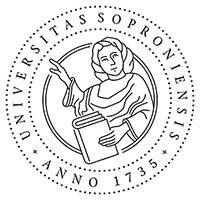Postmodern Childhood? - Children in a Japanese Cartoon
Abstract
What kind of childhood is pictured on a Japanese cartoon? I would like to know if this childhood could be concerned as a postmodern viewpoint? ln my presentation I would like to analyse a Japanese cartoon, Kiki’s delivery service – which is not so familiar for Hungarians. My research topic is about childhood in space and time. This anime is about a little girl who wants to be a witch; in that case we can concern it as a paraphrase of the medieval witch traditions. The collective was mostly Japanese, but they wished to introduce us an ideal American-European childhood. In my presentation I am using the English and Hungarian traditions and bibliographies of the History of Childhood.
References
A rajzfilm (képek forrása): Kiki a boszorkányfutár (魔女の宅急便 Mayo no takkyoubin – eredeti cím) (1989) animált rajzfilm, rendezte: Hayao Miyazaki, a mű alapjául szolgáló könyvet írta: Eiko Kadono, gyártó: Studio Ghibli, Koganei, Tokyo, Japán
Bakos Attila (2009): Morzsák a magyar repüléstörténet hőskorából. (online) közzétevő intézmény: Magyar Repüléstörténeti Társaság, URL: http://www.webkings.hu/mrt93j/index.php?option=com_content&task=view&id=49&Ite mid47, (2010. december 13.)
Bangó Jenő (2008): Niklas Luhmann rendszerelmélete és a konstruktivista nevelés. In: Útkeresés a posztmodernben. Összegyűjtött szociológiai esszék és tanulmányok 2000 – 2008, Mundus, Budapest, 200.
Cavalarro, Dani (2006): The animé art of Hayao Miyazaki. (online). közzétevő intézmény: Mc Farland and Company Inc. Publishers, North Carolina, USA, URL: http://books.google.hu/books?id=N3e00UlzHjgC&printsec=frontcover#v=onepage&q&f=fale, hozzáférés dátuma: 2010. december 10., 9.
Franz, Marie - Luise von (1995): Női mesealakok. Európa, Budapest
Golnhofer Erzsébet-Szabolcs Éva (2005): Gyermekkor: nézőpontok, narratívák. Eötvös József Könyvkiadó, Budapest
James, A. – Prout, A. (szerk., 1997): Constructing an Reconstructing Childhood: Co Group, London, Washington, D.C
Jean-Francois Lyotard (1993a): A posztmodern állapot. In: Jürgen Habermas–Jean-Francois Lyotard–Richard Rorty (szerk): A posztmodern állapot. Századvég, Budapest, 7., 24.
Jean-Francois Lyotard (1993b): A történelem egyetemessége és a kultúrák közti különbségek. In: Jürgen Habermas–Jean-Francois Lyotard–Richard Rorty (szerk): A posztmodern állapot. Századvég, Budapest, 251., 252.
Kálmán C. György (2000): Harry Potter játékai. In: Café Babel, 2000/1, 37.szám, 119.
Kurnit, Paul (1999): Kids Getting Older Younger. (online) közzétevő intézmény: Advertising Educational Foundation honalpja URL: http://www.aef.com/on_campus/classroom/speaker_pres/data/35 (2010. december 10.)
McCarty, Helen (2002): Hayao Miyazaki Master of Japanese Animation. (online), közzétevő intézmény: Stone Bridge Press, Berkeley, URL: http://books.google.hu/books?id=4YPh2_D9q2EC&printsec=frontcover#v=onepage&q& f=flse (2010. december 10.)
Miyazaki, Hayao (1989): The Hopes and Spirit of Contemporary Japanese Girls. In: The Art of Kiki's Delivery Service. (online), közzétevő intézmény:: Tokuma Shoten, Tokio URL: http://www.nausicaa.net/miyazaki/interviews/kiki_foreword.html (2010. december)
Németh András–Pukánszky Béla (2004): A pedagógia problématörténete. Gondolat, Budapest.
UNESCO World Heritage honlapja (2010): Hanseatic town of Visby. (online), közzétevő intézmény: UNESCO World Heritage, URL: http://whc.unesco.org/en/list/731 (2010. december 13.)
Szabolcs Éva (2004): „Narratívák” a gyermekkorról. In: Iskolakultúra, 2004/3., 27–31.
Winn, Marie (1990): Gyermekek gyermekkor nélkül. Gondolat, Budapest, 104.
Downloads
Published
Issue
Section
License
Copyright (c) 2012 Endrődy-Nagy Orsolya

This work is licensed under a Creative Commons Attribution-NonCommercial-NoDerivatives 4.0 International License.








